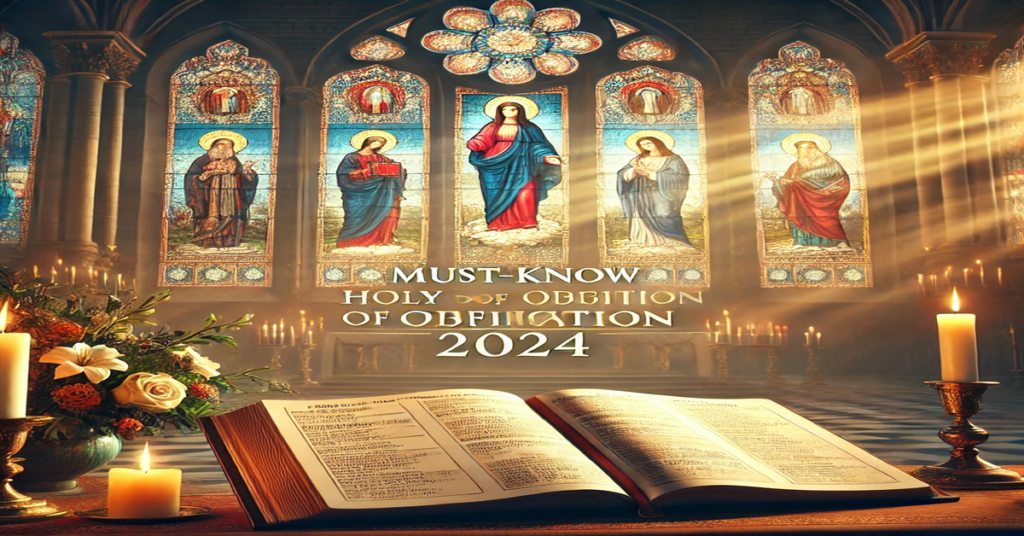In the Christian faith, Holy Days of Obligation are special days set apart for worship and reflection. They hold a significant place in the liturgical calendar, often commemorating key events in the life of Christ, the Virgin Mary, or the saints. For Catholics, these days are marked by the requirement to attend Mass and refrain from unnecessary work. This article explores the Holy Days of Obligation for 2024, their historical and theological significance, and how they are observed worldwide.
What Are Holy Days of Obligation?
Holy Days of Obligation are specific days within the Christian liturgical year, primarily observed in the Catholic Church, when the faithful are required to attend Mass and abstain from unnecessary labor. These obligations underscore the importance of worship and community in Catholic life. The Code of Canon Law (Can. 1246) outlines the guidelines for observing these days.
The Role of Holy Days of Obligation
The purpose of these days is to:
- Honor key mysteries of the Christian faith: These days celebrate central events like the Incarnation, Resurrection, and Pentecost.
- Deepen spiritual connection: Attending Mass and reflecting on these events fosters a deeper understanding of faith.
- Promote unity: By gathering for communal worship, Catholics strengthen their ties to the global Church.
Holy Days of Obligation in 2024
Here is a list of the Holy Days of Obligation for 2024, as observed in most parts of the world. Note that specific observances can vary by country, depending on local episcopal conferences and their decisions.
1. Solemnity of Mary, Mother of God (January 1)
This day honors the Virgin Mary as the Mother of Jesus Christ, emphasizing her role in salvation history. It is a time to reflect on Mary’s humility and obedience to God’s will.
- Historical Significance: Instituted in the early centuries of the Church, this feast underscores Mary’s divine motherhood and her pivotal role in the Incarnation.
- Celebration: Mass readings focus on Mary’s role in Christ’s life, and many faithful pray the Rosary or attend special Marian devotions.
2. Ascension of the Lord (May 9 or May 12)
The Feast of the Ascension commemorates Jesus’ return to the Father, 40 days after his Resurrection.
- Historical Significance: The Ascension signifies the completion of Christ’s earthly mission and the beginning of the Church’s mission to evangelize.
- Celebration: Depending on local practice, this feast may be celebrated on Ascension Thursday (May 9) or the following Sunday (May 12).
3. Assumption of the Blessed Virgin Mary (August 15)
This day celebrates Mary’s bodily assumption into heaven, affirming her immaculate nature and eternal union with God.
- Historical Significance: Declared a dogma by Pope Pius XII in 1950, the Assumption is rooted in the belief of Mary’s unique role in salvation.
- Celebration: Many countries hold processions, and churches often organize special Marian hymns and prayers.
4. All Saints’ Day (November 1)
All Saints’ Day honors all saints, known and unknown, who have achieved eternal glory.
- Historical Significance: Dating back to the 4th century, this feast encourages Catholics to seek inspiration from the lives of the saints.
- Celebration: Families may visit cemeteries, light candles, and pray for the dead, acknowledging the communion of saints.
5. Immaculate Conception of the Blessed Virgin Mary (December 8)
This feast celebrates the doctrine that Mary was conceived without original sin.
- Historical Significance: Proclaimed a dogma in 1854 by Pope Pius IX, this day highlights Mary’s purity and readiness to be the Mother of God.
- Celebration: Devotions and prayers often focus on Mary’s unique role in God’s plan of salvation.
6. Christmas Day (December 25)
Christmas commemorates the birth of Jesus Christ, the Savior of the world.
- Historical Significance: One of the oldest and most celebrated feasts in Christianity, Christmas marks the mystery of the Incarnation.
- Celebration: Midnight Mass, carols, and nativity scenes are central to the observance of this holy day.
Regional Variations in Observance
While the above list covers the universal Holy Days of Obligation, some countries observe additional feasts or transfer obligations to the nearest Sunday. Here are a few notable examples:
In the United States:
- Epiphany (January 7 in 2024): Often transferred to Sunday.
- Corpus Christi: Celebrated on the Sunday following Trinity Sunday.
In Europe:
- St. Joseph’s Day (March 19): A Holy Day of Obligation in some countries, such as Spain and Italy.
- Epiphany: Retains its traditional date, January 6, in many European countries.
In Asia and Africa:
Local episcopal conferences may add or modify observances to reflect cultural and pastoral needs.
How to Prepare for Holy Days of Obligation
1. Mark Your Calendar
Plan ahead by noting the dates of Holy Days of Obligation and any adjustments made by your diocese.
2. Participate in the Sacraments
Receiving the Sacrament of Reconciliation before attending Mass can deepen your spiritual experience.
3. Engage in Prayer and Reflection
Prepare your heart by meditating on the significance of the feast. Praying the Rosary or reading relevant Scripture passages can help.
4. Foster Community
Attend Mass with family or friends to share in the joy and solemnity of these occasions.
Common Misunderstandings About Holy Days of Obligation
1. Are all Sundays Holy Days of Obligation?
Yes. Every Sunday is considered a Holy Day of Obligation because it celebrates the Resurrection of Christ.
2. Can obligations be dispensed?
Bishops can grant dispensations for specific reasons, such as severe weather or pastoral considerations.
The Importance of Holy Days of Obligation
Holy days of obligation 2024 serve as spiritual milestones, drawing Catholics closer to God through worship, reflection, and community. They remind the faithful of their shared beliefs and encourage deeper engagement with the mysteries of faith.
In a world filled with distractions, these sacred days offer an opportunity to pause and reconnect with the divine. By observing these days with reverence, Catholics honor the central truths of their faith and express their commitment to living a life rooted in the Gospel.
FAQs About Holy Days of Obligation
1. What happens if I miss a Holy Day of Obligation? Missing a Holy Day of Obligation without a valid reason (such as illness) is considered a grave matter and may require confession.
2. Are Holy Days of Obligation the same in every country? No. Local episcopal conferences can adjust the list of Holy Days of Obligation to suit pastoral needs.
3. Is attending Vigil Mass the night before acceptable? Yes. Vigil Masses fulfill the obligation for Holy Days.
4. Can non-Catholics attend Holy Day Masses? Non-Catholics are welcome to attend Mass, though they may not receive the Eucharist unless certain conditions are met.
5. How are Holy Days of Obligation different from Solemnities? All Holy Days of Obligation are solemnities, but not all solemnities are Holy Days of Obligation.
6. What should I do if I cannot attend Mass on a Holy Day? If you cannot attend due to illness or another serious reason, you are excused, but you should still dedicate the day to prayer and reflection.
By understanding and observing Holy Days of Obligation, the faithful can deepen their relationship with God and participate more fully in the life of the Church.







